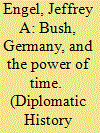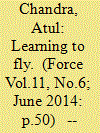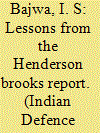|
|
|
Sort Order |
|
|
|
Items / Page
|
|
|
|
|
|
|
| Srl | Item |
| 1 |
ID:
131446


|
|
|
|
|
| Publication |
2013.
|
| Summary/Abstract |
George H.W. Bush backed German reunification with a puzzling degree of enthusiasm. His strategic reasoning was clear and not in dispute, as he desired to keep a unified Germany enmeshed within NATO. Less obvious, however, is his general forgiveness of Germany's past, for which he was pilloried. Yet history was much on Bush's mind in reaching these decisions. Germans had learned from the past, he argued. Europeans had not. They could not keep the peace no matter their ongoing political consolidation, his administration concluded by reading European history, without Americans in their midst. Bush backed unification, therefore, to ensure NATO's survival and thus an ongoing American presence on the continent. By studying Bush's sense of history, and a policymaker's historical sensibility more broadly, historians can thus gain greater insight into this decision and how strategic decisions are more generally formed
|
|
|
|
|
|
|
|
|
|
|
|
|
|
|
|
| 2 |
ID:
131040


|
|
|
|
|
| Publication |
2014.
|
| Summary/Abstract |
Just over a year ago in July 2013, the High Level Committee on Manufacturing (HLCM) headed by the then Prime Minister Manmohan Singh gave the go-ahead for the manufacture of a civil aircraft in India. The decision was taken with the view that this was "a strategic sector where there was a need to have a presence in the long term, particularly in view of the rapid growth of the aviation sector." As a result "the HLCM took a major strategic decision for the development of a civilian aircraft, of a 70-100 seater range to begin with, in India."
|
|
|
|
|
|
|
|
|
|
|
|
|
|
|
|
| 3 |
ID:
130075


|
|
|
|
|
| Publication |
2014.
|
| Summary/Abstract |
The Government's 'White Paper' relating to India-China Boundary issue, published between T951 and i960, clearly indicated the adversarial bilateral relations between India and China. The increasingly acrimonious exchanges on the boundary question indicated that it could precipitate matters and result in armed clashes. The incident in Longju on August 25, T959 and Kongka Pass on October 21, T959 were pointers to the determination and political will at China to stake her claims even at the cost at a war. This should have been the turning point for India; she should have begun preparing for an armed showdown to secure her territorial
integrity. Raising ot additional infantry and Artillery units and tormation Head Quarters, raising of Headquarters lV Corps, augmenting the transport tleet, inducting additional helicopters and transport aircratt, constructing roads, and redeploying torces to meet possible contingencies should have been commenced in right earnest then. Such preparation was mandatory to support a strategic decision at the magnitude as was emerging.
"Nobody is driven into war by ignorance, and no one who thinks he will gain anything trom it is deterred by fear ..... ..when there is mutual tear men think twice before they make aggressions upon another" -Hermocrates as attributed by Thucydides
|
|
|
|
|
|
|
|
|
|
|
|
|
|
|
|
|
|
|
|
|